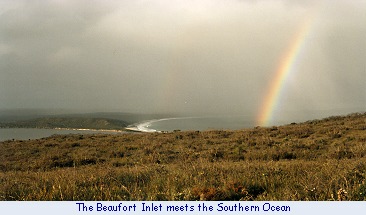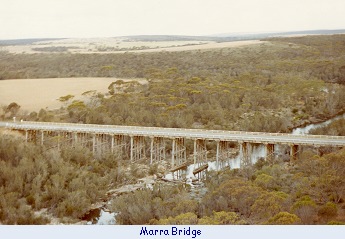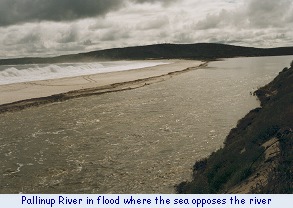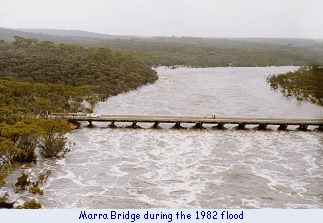 "It rained for about ten days, I think, on and off. We kept rain records and
kept throwing out the gauge, it would be full and out would go that lot and
then there would be another lot and that was incredible. It rained from the
south-east, I think they were upper atmospheres or middle levels or
something that didn't move. I had a two-month old baby and I was a bit
concerned that if anything went amiss, we had no telephone of course. The
telephone was carried away with the river and everywhere you looked it was
just river, just swirling along, trees going down, the occasional pair of horns
going down, it was very dramatic. I forget the level but it was recorded out
there at Chillinup but it was a record so far I think in our lifetime.
"It rained for about ten days, I think, on and off. We kept rain records and
kept throwing out the gauge, it would be full and out would go that lot and
then there would be another lot and that was incredible. It rained from the
south-east, I think they were upper atmospheres or middle levels or
something that didn't move. I had a two-month old baby and I was a bit
concerned that if anything went amiss, we had no telephone of course. The
telephone was carried away with the river and everywhere you looked it was
just river, just swirling along, trees going down, the occasional pair of horns
going down, it was very dramatic. I forget the level but it was recorded out
there at Chillinup but it was a record so far I think in our lifetime.
We couldn't get anywhere and for about 18 months and afterwards there were detours all through the bush tracks that we used to go down to the Pallinup or to Cape Riche, or anywhere for that matter on those bush tracks. There were these huge detours, the swamps were full for ages, the yate swamps, it was incredible it really was. I think we had about 30 inches that year, because we got over that lot but then upstream from the Corackerup there was a deluge at April, it was about Easter. There was a big storm and down came the Corackerup and it wiped everything out, it was there to be seen for a long time where it hit the banks.
Well certainly after the 1955 floods there was nothing left. It was as bald as
a badger. But then up came the Casuarina, they came up like mad, particularly
around the crossings at Chillinup because most of the Yates had gone. But
of course Yates seem to regenerate and they seem to grow up quite quickly,
but I don't suppose anything is quicker than the Casuarinas or the Acacias.
The jams would have been there quickly too probably in certain parts."
Ruth Moir
(1955 flood)
"There was a little creek came in on the opposite side of the river (at Sandalwood) so the water backed up that, but it would have been at least a kilometre wide there, where it was backed up round that little creek. It was higher than any previous flood and my uncle told me there was a flood in 1914, I think he said, and they'd put a fence up higher than that flood and it took out that fence, so it was higher than any previous flood. At that part of the river it was higher than any flood since.
It certainly changed the river. The river there had flat-topped yates, really
big, like you couldn't put your arms around them, probably take almost two
people to put their arms around them they were so big. It just took them
out, it just took all the vegetation out of the riverbed and it was just a rocky
bed. It grew up again and some time in the early 80s there was another
flood, nearly as big but not quite, and it took it out again. So in my lifetime
I've seen that riverbed cleaned out twice, and it's grown up again. But the
second time the trees weren't as big, they weren't as massive so they must
have been much, much older. That was in year 55."
Bill Moir
(1955 flood)
 "At one stage there were a lot of people this side of the river and there was
a flood and they had to all pack up and they worked their way back to Marra
by road. About sixty people camped in the shed and one family lived with us
up at the house.
"At one stage there were a lot of people this side of the river and there was
a flood and they had to all pack up and they worked their way back to Marra
by road. About sixty people camped in the shed and one family lived with us
up at the house.
A father and son combination had a beautiful boat with the curved oars.
We'd never seen those curved oar blades before and they did the ferrying
and they left the oars with dad after they went. Yes, we had great fun really
because there were youngsters in that group. We used to ride the horses and
of course we didn't have enough saddle horses so we took to the team horses
and some of them were pretty big. Some of these little people sitting on the
back of a wide Clydesdale, they had their legs out there not down there. It
was said that if you fell off a horse seven times you became a good rider, so
it was no trouble to fall off a horse seven times in one day."
Brian Moir
"Mum used to tell the story, dad had been to Cape Riche, I don't know how but in the buggy. When he came back the river had come down and mum went down to the river, she knew it was down and across the crossing and so on. Anyhow he swam across hanging onto one of the horses tails as he came across, to get back.
Tom Marwick out of York and he used to come down with Basil Craig, who
owned one of the big hotels in York. They were two that came from York but
then there was a party of York sportsmen. Eminent families in York, well
they were all farmers or associated with farmers. Anyhow when they went
down they used to go well supplied with liquor and they were very proud of
their mountain of bottles that they had built there during their stay at the
river. When they went the following year there'd been a flood through the
camp and the bottles were scattered hither, thither and wither. I don't know
where they got the wire from but they got the wire and they fenced them in,
collected them and fenced them in. They were very proud about that."
Betty Sewell
 "Well the phone line was a scream because that was done before I got there
with fencing wire. Mr Hassell and Keith's father, Cleaver, and Cape Riche
and Marra, they were on the overland telephone line. That would be the first
thing to go when the river rose. It didn't take much of a flood, it was only
slung across on two poles across the river and away that would go. But in
the beginning of settlement out around us with the conditional purpose
blocks that were thrown open people would rely on us to ring the Eastern
States or anywhere, it was the only phone for a long way around. It was
terrible it really was, it was a very poor phone service you would have to
scream and yell, it created a lot of tense moments but it was very humorous
really."
"Well the phone line was a scream because that was done before I got there
with fencing wire. Mr Hassell and Keith's father, Cleaver, and Cape Riche
and Marra, they were on the overland telephone line. That would be the first
thing to go when the river rose. It didn't take much of a flood, it was only
slung across on two poles across the river and away that would go. But in
the beginning of settlement out around us with the conditional purpose
blocks that were thrown open people would rely on us to ring the Eastern
States or anywhere, it was the only phone for a long way around. It was
terrible it really was, it was a very poor phone service you would have to
scream and yell, it created a lot of tense moments but it was very humorous
really."
Ruth Moir
"I can remember that one very vividly because we actually went down to the Marra Bridge and the water would have been maybe 18 inches from lapping the decking of the bridge. We went out into the middle of the bridge to have a little bit of a sticky beak and just at that moment a great big yate log or something came along and rammed into one of the pylons and the whole bridge sort of shook. Well I reckon I got off that bridge that fast it would have made Cathy Freeman look like she was walking backwards.
But that was a huge big flood event and a huge volume of water, unbelievable,
and it went out, of course broke the bar and went out into the ocean and
made a great big brown mark right out into the ocean."
Charlie Hick
(January 1982 flood)
 "I think the nature of the flooding changed because in the '55 flood all the
clearing was in Gnowangerup, Tambellup, Borden areas and they were only
just starting to clear the Jerramungup-Corackerup Creek areas you see. So
the water came from the higher reaches of the river and that's why it was so
high at Sandalwood. In the flood in the 80s it didn't run anywhere near as
high at Sandalwood but down towards the mouth it must have run nearly as
high because it was lapping the decking of the Marra Bridge (which was
built above the high water mark). But the nature of the [flooding] had changed
because you'd have all the clearing from Jerramungup and Corackerup so
the creeks there were feeding the river lower down. So there really was a
change in the nature of the flooding."
"I think the nature of the flooding changed because in the '55 flood all the
clearing was in Gnowangerup, Tambellup, Borden areas and they were only
just starting to clear the Jerramungup-Corackerup Creek areas you see. So
the water came from the higher reaches of the river and that's why it was so
high at Sandalwood. In the flood in the 80s it didn't run anywhere near as
high at Sandalwood but down towards the mouth it must have run nearly as
high because it was lapping the decking of the Marra Bridge (which was
built above the high water mark). But the nature of the [flooding] had changed
because you'd have all the clearing from Jerramungup and Corackerup so
the creeks there were feeding the river lower down. So there really was a
change in the nature of the flooding."
Bill Moir
We just happened to be down there looking for wildflowers and it was a
fairly damp year because the roads were very slippery into the Pallinup. We
met someone coming out on the way in and he said, "Oh, it's gone out, with
a bit of help". I think someone had been down there with a spade or something
and we went down there straight away and there it was running parallel with
the beach, between the beach and the humpies down there. It was quite
unique to see this going out that way and so we were quite happy about that
and Keith took some photos and we came home thinking we'd seen
something."
Ruth Moir
(1997 flood)



